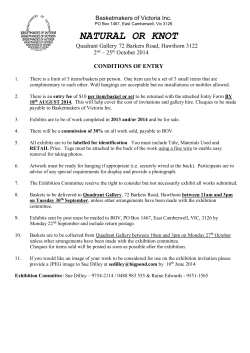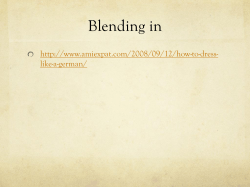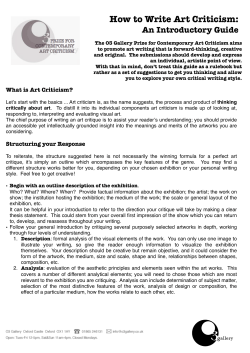
From Dachau to the New York catwalk dealers’ diary
28 15th November 2014 dealers’ diary Anna Brady reports email: annabrady@atgmedia.com tel: 020 3725 5526 Back to her roots as art scene starts to sprout ON November 22 Sally Burgess of Clerkenwell Fine Art opens a new gallery in the Old Bank House, a 17th century premises in the Somerset market town of Castle Cary. The gallery, founded in 2008, specialises in British and European art, particularly of the British Visionary Pastoral tradition, from the 18th century to the present day. Although Sally had no idea of its imminent launch when she moved to Castle Cary, Hauser and Wirth’s new Contemporary art gallery in Bruton, which has so far notched up over 50,000 visitors since it opened in July, is just a few minutes’ drive away and the area has suddenly risen from a relative backwater, artistically, to a thriving cultural hub. Of the decision to open in Castle Cary, Sally said: “I’m from Somerset and I fell in love with the town, having been stranded there during the flooding of 2012 when all the train lines were down. “When I bought the gallery, I had no idea that I actually had deep family connections here. My great grandfather was the landlord of the ancient George Inn and my grandparents were married in Cary Church and loved the town throughout their lives.” The gallery will continue to exhibit at London fairs and their showroom in Clerkenwell will remain open by appointment. www.clerkenwellfineart.com From Dachau to the When Brian Stonehouse (191898) joined the Royal Artillery in 1939, a recent graduate of Ipswich Art School, he was dismayed to be posted to the Orkney Islands where he was both bored and, as a fluent French speaker, rather wasted. He craved adventure and was soon recommended for the Special Operations Executive (SOE), an elite team of individuals trained to infiltrate Nazi Europe. A talented art graduate, Stonehouse was disguised as a French art student, with a B2 suitcase radio hidden in his artist’s box, but after only three and a half months transmitting from inside occupied France, he was arrested by the Gestapo. He then spent two and a half years as a prisoner of war, often tortured and put in to solitary confinement, incarcerated in three different French prisons and the five concentration and labour camps of Neue Bree, Mauthausen, Wiener Neudorf, Natzweiler-Stuthof and, for the last few months of the war, Dachau. Remarkably he survived. The Imperial War Museum now holds Stonehouse’s drawings of the liberation of Dachau and the War Crimes Tribunals. But, within a few years he was ensconced in the most different world imaginable to the horror of the concentration camps, as a darling of the New York fashion world and a well-known artist and fashion illustrator, for Vogue among other glossies. And it is a group of 40 of these languorous fashion drawings from the 1950s and early ‘60s that are the subject of Abbott & Holder’s new exhibition to celebrate the publication of a new book by Frederic A. Sharf titled Brian Stonehouse: Artist, Soldier, War Hero, Fashion Illustrator, which recounts the story of this extraordinary life. Stonehouse’s sudden move from wartorn Europe to the glamour of New York New York catwalk 10 uestions Lawrence Hendra Associate Director, Philip Mould & Company, London www.philipmould.com 1 How long have you been dealing? 11 years – since the age of 13. 2 Do you do any fairs? Masterpiece and more recently LAPADA (where we focus solely on portrait miniatures). 3 What was your first job? Picture cataloguer at W.H. Lane & Son in Penzance. 4 Best and worst thing about being a dealer? Best, the thrill of the chase and the feeling of satisfaction when you find something interesting. Worst, when you don’t find anything interesting. 5 Best buy and biggest mistake? Best buy, a nice Reynolds a few years back on the continent. Biggest mistake, not learning French at school. 6 Dream object? An early 1950s canvas by Peter Lanyon. 7 Biggest threat to the trade at the moment? Fakes – it’s terrifying how many you see at the moment. 8 Guiltiest pleasure? Novelty mugs. 9 Alternative career? Architectural historian. 10 Michelin Star or greasy spoon? Can it be claimed on expenses? “Stonehouse’s sudden move from war-torn Europe to the glamour of New York came about somewhat by chance” came about somewhat by chance. During the preparation of the War Crimes trials, he met Harry Haller, a socialite American major, who noted his talent and supported his move to America in 1946. Haller recommended him as a society portrait painter (his sitters included the actress Tallulah Bankhead) and then such works caught the eye of Jessica Daves, the fashion editor of Vogue who thought his style would be perfect for fashion illustration. In 1952, Stonehouse was the first new illustrator to be taken on by Vogue since before the war. He stayed at Vogue for as long as Daves was editor in chief (until 1962), a contemporary of ‘Eric’ (Carl Erickson) and René Bouché. In February 2013, the American collector, scholar and author Frederic A. Sharf, author of the new book on Stonehouse, purchased a group of Stonehouse’s work from Philip Athill, director of Abbott & Holder, and thus began Sharf’s fascination with the artist. He traced Stonehouse’s younger brother Dale and his wife Ida, who had a shed full of his letters and memorabilia which Sharf acquired and collated. The result is this book and exhibition at Abbott & Holder, which runs from November 14 to December 23 at 30 Museum Street, opposite the British Museum in London. All of the works on show are from the artist’s estate and will be for sale, at prices from £750 to £3000, with an average of £1900. The Stonehouse Collection of drawings, bought by Sharf last year from Abbott & Holder, is now in the Boston Museum of Fine Arts. www.abbottandholder-thelist.co.uk Q Antiques Trade Gazette If you are a dealer and would like to be featured in 10 Questions email annabrady@atgmedia.com Pictured here is a selection of fashion drawings, created for an American fashion magazine (probably Vogue) by Brian Stonehouse, which will be included in Abbott & Holder’s exhibition of Stonehouse’s work opening this week. Above left: The Yellow Coat, watercolour and gouache with fibre-tip pen shaped for layout, 18 x 15in (46 x 38cm), c.1955, £2250. Above: The Pencil Skirt, ink and gouache with fibre-tip pen on blue paper, 2ft x 14in (61 x 36cm), c.1955, £2250. Left: The Orange Dress, gouache and ink with fibre-tip pen on tan paper, for Vogue, 2ft 3in x 18in (69cm x 46cm) c.1955, £2250. Far left: The Striped Tee-Shirt, charcoal, ink and gouache on blue/grey card, 2ft x 16in (61 x 41cm) c.1960, £1750. Athill also to focus on Sorrell and the Roman connection AS well as Abbott & Holder’s exhibition of the work of Brian Stonehouse, the gallery’s director Philip Athill will be co-curating a loan exhibition at next year’s Works on Paper Fair (February 5-8) at the Science Museum. The show is titled Alan Sorrell (1904-1974) – The Man who created Roman Britain and, co-curated with Sorrell’s daughter Julia Sorrell, it includes works loaned by the artist’s family. Sorrell was fascinated by the Roman period and made many archaeological drawings. The exhibition includes a selection of atmospheric illustrations from his books such as Roman Britain (1961) and Imperial Rome (1970). Julia Sorrell, herself an artist, will give a talk at the fair, discussing her father’s life and work, on Thursday February 5 at 3pm. www.worksonpaperfair.com 29
© Copyright 2025











